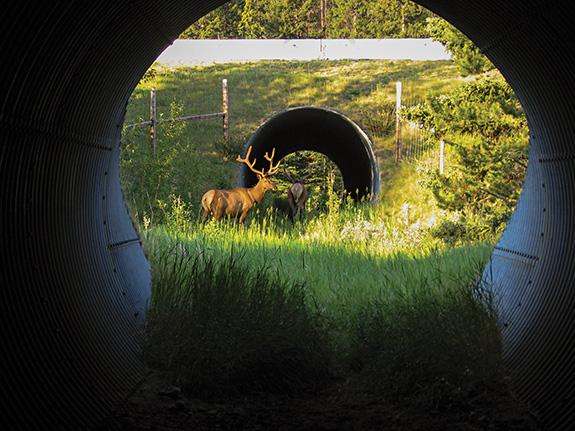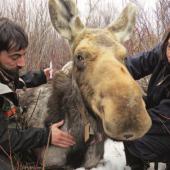Killer Cars
For wildlife, they're weapons of mass destruction.
If you drive east on I-90 past the Bear Canyon exit, you may notice a section of high fencing along the sides of the interstate. Look more closely and you’ll find four breaks in the fence: elevated platforms where animals that get trapped inside the fence can jump out, but are not able to get in. Not surprisingly, these are referred to as “jump-outs.” The fencing and jump-outs, along with extra large “cattle guards” at the on- and off-ramps, are part of an effort to reduce roadkill and help protect motorists; they were installed by the Montana Department of Transportation in 2007 and 2008.
Before the building of the wildlife-exclusion fencing, the Craighead Institute, in collaboration with the Montana State University’s Western Transportation Institute, studied roadkill on Bozeman Pass over a ten-year period. We recorded locations where carcasses were found and evaluated various ways to reduce animal-vehicle collisions, driving back and forth from Bozeman to Livingston about three times a week.
Between January 2001 and June 2010, 2,272 animals representing 49 different species of mammals, birds, and reptiles were recorded as roadkill. Of those, there were 947 deer, 50 elk, 9 mountain lions, 12 badgers, 25 black bears, 9 moose, one pine marten, 40 porcupines, 195 raccoons, and 305 skunks, as well as many others. Roadkill often attracts scavengers; many of the 67 coyotes that were killed were hit while feeding on roadkill.
Similarly, some of the 58 owls and 15 raptors killed were scavenging roadkill or hunting rodents along the highway edge. How many more were killed we don’t know, but the verified count is depressingly high as it is. Various studies show that visible roadkill is 50% or less of actual animals killed; many wander off before dying eventually somewhere far from the road.
Animals all need to move, and many are forced to cross roads to get where they need to go. A cautious estimate is that close to one million vertebrates are killed on roads EACH DAY in the United States. Besides the damage to vehicles and injuries to motorists, that is a huge waste of biodiversity.
What can be done about this? The wildlife fencing on Bozeman Pass is one example of what we need to do. Follow-up surveys showed that roadkill within the fence was reduced almost to zero, while more animals followed the fence to pass safely under the interstate below the railroad bridge or through the large culverts on Rocky Creek. Creating a safe wildlife crossing like that is a complex issue; not only do the animals need a safe route over or under the highway, they need to have somewhere friendly to go on either side.
To successfully complete more wildlife crossings in a place like Bozeman Pass requires the cooperation of state and federal agencies, including the Federal Highway Administration, the Montana Department of Transportation, Montana Fish, Wildlife & Parks, the US Forest Service, and perhaps others. It requires support from the Burlington-Northern Railroad and multiple private landowners whose lands need to be crossed by wildlife. It requires work, and perhaps funding, from conservation organizations and land trusts.
It may sound like an impossible goal, but wildlife crossings are increasingly being built throughout the United States. In Montana alone we have numerous crossings on Hwy. 93, both north and south of Missoula. Wyoming, Idaho, Washington, and Alberta are neighboring jurisdictions with many such projects either completed or in the works. It may be a complex problem, but it is a problem that can be solved—crossing structures work, and they work well. The reduction of three deer collisions or one elk collision per year can pay for the cost of crossing structures over time and save citizens money in insurance deductibles, not to mention medical costs. And, these crossings can help greatly to maintain our vulnerable wildlife populations.
In addition to reducing wildlife mortality, crossings allow animals to move more freely across the countryside. We can begin to restore the connectivity of the landscape so that wildlife populations can acquire food, shelter, water, and greater genetic diversity, like the conditions that existed before Nelson Story drove the first large herd of longhorn cattle over the Bozeman Trail in 1866.
Bozeman Pass is a prime place for animals that need to move north and south within the Custer-Gallatin National Forest, and on a larger scale between the Greater Yellowstone Ecosystem and the Northern Continental Divide Ecosystem. Restoring Bozeman Pass as a wildlife corridor is one of the critical issues that needs to be addressed as the US Forest Service completes the Custer-Gallatin’s forest-plan revision. Animals need secure habitat to travel from the Hyalite-Porcupine Buffalo Horn Wilderness Study Area up to I-90 along the Gallatin Crest; the Forest Service can help ensure that.
Lance Craighead is a chief scientist at the Craighead Institute in Bozeman. To contribute to the Bozeman Pass project, visit craigheadresearch.org.













